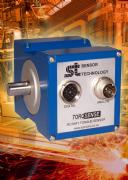 Add My Company
Add My Company
Sign In
TORQING SENSE FOR PROCESS PLANT CONTROL
28-11-2008

Plant monitoring and control is particularly vital in the continuous process industries, where multiple machines must act in harmony day after day and failure of a single machine can lead to massive consequential losses of production. With most machines driven through a rotating shaft, torque monitoring can identify problems before they become critical. Tony Ingham of Sensor Technology considers the techniques.
Say ‘process control’ and most people automatically think of monster-sized central computers running barely-fathomable SCADA software in a control room that would not be out of place at Cape Canaveral. But out on the plant floor, there may be literally thousands of simple sensors and switches, collecting data and feeding it back to the Beamoth.
These sensors are tracking every little change in the plant’s operating parameters, indictative of either the state the materials being worked or of the state of the machinery itself. For instance an increase in torque on a mixer drive may suggest that a mixture within is thicken up as expected, or alternatively that a seal or bearing is sticking and may soon fail altogether: either way this is vital information for the central computer to capture and assess.
Ultimately, process engineers want to transfrom material from one state to another, and to monitor variables indicative of the various stages of the process. Some parameters can be measured directly and simple – temperature for example. Others are more difficult to measure, so an often-used technique is to measure a related parameter (typically one related to the plant or machinery rather then the process material) and interpolate from this.
Significantly many types of process plant – mixers, pumps, conveyors - are motor driven, and measuring the motor output characteristics will often provide process information. For instance, the torque of the motor could suggest the quantity, speed or viscosity of the process material being worked.
Obviously, measuring the processing is the primary concern of the production engineers, but torque measurement has a second, equally important funtion. Because you are actually measuring plant performance, you get to see how the machinery is holding up. Knowing what to look for will give you early warning of breakdowns, allowing you to schedule pre-emptive maintenance. For a continuos process where downtime can cost thousands of pounds an hour in lost production, this can be critical - ultimately the difference between a health profit and a catastrohpic loss.
This all sound very useful, and actually measuring torque can be very simple. Not so long ago torque sensors required a fairly complicated and fragile array of slip rings connected to the rotating drive shaft of the machine under test. But now TorqSense provides a non-contact means fo taking the readings. In use, a couple of simple pads are glued to the side of the driveshaft and a TorqSense unit mounted close by. The TorqSense then starts monitoring torque, and and feeding it as a data signal to the SCADA control system
Principles
The pads are in fact tiny little piezoelectric combs encased in plastic. The combs are designed to open or close under the torque effect of their rotational speed on the drive shft. The greater the torque, the more the distortion.
The TorqSense unit emits a low powered radio frequency signal towards the combs, which reflect it back to the TorqSense. The reflected signal comes back at a changed frequency, the change being propotional to the distortion of the combs, and thus to the torque in the drive shaft.
The phyical phenominum which deforms the combs is called the Surface Affect Wave (SAW), a property first noted in 1885 by gentleman-scientist Lord John William Strutt Rayleigh. He postulated many possible used for SAWs, but was unable to realise practical use for any of his theories. It was not until the 1920s that they were shown t
For more information on TORQING SENSE FOR PROCESS PLANT CONTROL talk to Sensor Technology Ltd
Enquire Now
More News
List your company on FindTheNeedle.

